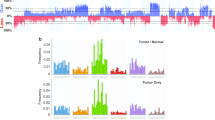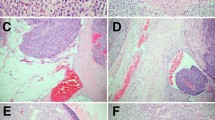Abstract
Background
The most common genetic change observed in adrenocortical carcinoma is loss of heterozygozity on chromosome 11q13. As genes on this chromosome may be important in the pathogenesis of adrenocortical carcinoma, we compared their expression profile between benign and malignant adrenocortical tissue.
Methods
We used the Affymetrix GeneChip (U133 plus 2.0) array in 54 adrenocortical tumors (11 carcinoma and 43 benign). Differential gene expression was defined as a twofold higher or lower gene expression level (p < 0.05). Differentially expressed genes on microarray analysis were validated by real-time quantitative reverse-transcriptase polymerase chain reaction (RT-PCR). The area under the receiver operating characteristic (ROC) curve (AUC) was used to determined the diagnostic accuracy of the differently expressed genes for distinguishing benign from malignant tumors.
Results
We found 25 of the 314 genes on chromosome 11q13 to be differentially expressed between adrenocortical carcinoma and benign adrenocortical tumor. All 25 were downregulated in adrenocortical carcinoma by 2-fold to 4.8-fold; 21 were validated to be differentially expressed by RT-PCR (Pearson’s coefficient > 0.5). Six genes (SERPING1, MRPL48, TM7SF2, DDB1, NDUSF8, PRDX5) validated by RT-PCR were significantly differentially expressed between benign and malignant adrenocortical tumors (p < 0.05) with an overall accuracy of 89% for SERPING1, 91% for MRPL48, 87% for TM7SF2, 88% for DDB1, 91% for NDUFS8, and 89% for PRDX5. The AUC was 0.89 for the combination of SERPING1, MRPL48, TM7SF2, DDB1, and NDUFS8.
Conclusions
We have identified 25 genes located on chromosome 11q13 that are downregulated in adrenocortical carcinoma and may be candidate tumor suppressor genes. Six of these genes were good diagnostic markers for distinguishing adrenocortical carcinoma from adenoma.

Similar content being viewed by others
References
Kjellman M, Kallioniemi OP, Karhu R et al (1996) Genetic aberrations in adrenocortical tumors detected using comparative genomic hybridization correlate with tumor size and malignancy. Cancer Res 56:4219–4223
Koch CA, Pacak K, Chrousos GP (2002) The molecular pathogenesis of hereditary and sporadic adrenocortical and adrenomedullary tumors. J Clin Endocrinol Metab 87:5367–5384
Fehaily MA, Duh QY (2003) Adrenocortical carcinoma. In Clark OH, Duh QY, Perrier N et al (eds) Endocrine Tumors: American Cancer Society, Atlas of Clinical Oncology. BC Decker, Hamilton, Ontario, pp 123–130
Skogseid B, Larsson C, Lindgren PG et al (1992) Clinical and genetic features of adrenocortical lesions in multiple endocrine neoplasia type 1. J Clin Endocrinol Metab 75:76–81
Houdelette P, Chagnon A, Dumotier J et al (1989) Malignant adrenocortical tumor as a part of Wermer’s syndrome. Apropos of a case. J Chir (Paris) 126:385–387
Sidhu S, Sywak M, Robinson B et al (2004) Adrenocortical cancer: recent clinical and molecular advances. Curr Opin Oncol 16:13–18
Heppner C, Reincke M, Agarwal SK et al (1999) MEN1 gene analysis in sporadic adrenocortical neoplasms. J Clin Endocrinol Metab 84:216–219
Kjellman M, Roshani L, Teh BT et al (1999) Genotyping of adrenocortical tumors: very frequent deletions of the MEN1 locus in 11q13 and of a 1-centimorgan region in 2p16. J Clin Endocrinol Metab 84:730–735
Schulte KM, Mengel M, Heinze M et al (2000) Complete sequencing and messenger ribonucleic acid expression analysis of the MEN I gene in adrenal cancer. J Clin Endocrinol Metab 85:441–448
Wachenfeld C, Beuschlein F, Zwermann O et al (2001) Discerning malignancy in adrenocortical tumors: are molecular markers useful? Eur J Endocrinol 145:335–341
Davis AE (2005) The pathophysiology of hereditary angioedema. Clin Immunol 114:3–9
Bennati AM, Castelli M, Della Fazia MA et al (2006) Sterol dependent regulation of human TM7SF2 gene expression: role of the encoded 3beta-hydroxysterol Delta14-reductase in human cholesterol biosynthesis. Biochim Biophys Acta 1761:677–685
Cang Y, Zhang J, Nicholas SA et al (2007) DDB1 is essential for genomic stability in developing epidermis. Proc Natl Acad Sci USA 104:2733–2737
Lescuyer P, Martinez P, Lunardi J (2002) YY1 and Sp1 activate transcription of the human NDUFS8 gene encoding the mitochondrial complex I TYKY subunit. Biochim Biophys Acta 1574:164–174
Procaccio V, Wallace DC (2004) Late-onset Leigh syndrome in a patient with mitochondrial complex I NDUFS8 mutations. Neurology 62:1899–1901
Kropotov A, Serikov V, Suh J et al (2006) Constitutive expression of the human peroxiredoxin V gene contributes to protection of the genome from oxidative DNA lesions and to suppression of transcription of noncoding DNA. FEBS J 273:2607–2617
Velázquez-Fernández D, Laurell C, Geli J et al (2005) Expression profiling of adrenocortical neoplasms suggests a molecular signature of malignancy. Surgery 138:1087–1094
Giordano TJ, Thomas DG, Kuick R et al (2003) Distinct transcriptional profiles of adrenocortical tumors uncovered by DNA microarray analysis. Am J Pathol 162:521–531
Slater EP, Diehl SM, Langer P et al (2006) Analysis by cDNA microarrays of gene expression patterns of human adrenocortical tumors. Eur J Endocrinol 154:587–598
de Fraipont F, El Atifi M, Cherradi N et al (2005) Gene expression profiling of human adrenocortical tumors using complementary deoxyribonucleic acid microarrays identifies several candidate genes as markers of malignancy. J Clin Endocrinol Metab 90:1819–1829
Sanchez M, Galy B, Dandekar T et al (2006) Iron regulation and the cell cycle: identification of an iron-responsive element in the 3'-untranslated region of human cell division cycle 14A mRNA by a refined microarray-based screening strategy. J Biol Chem 281:22865–22874
Hayashi H, Wakusawa S, Motonishi S et al (2006) Genetic background of primary iron overload syndromes in Japan. Intern Med 45:1107–1111
Adachi N, Karanjawala ZE, Matsuzaki Y et al (2002) Two overlapping divergent transcription units in the human genome: the FEN1/C11orf10 locus. Omics 6:273–279
Mourtada-Maarabouni M, Kirkham L, Farzaneh F et al (2004) Regulation of apoptosis by fau revealed by functional expression cloning and antisense expression. Oncogene 23:9419–9426
Toffoli G, Viel A, Tumiotto L et al (1992) Expression of glutathione-S-transferase-pi in human tumours. Eur J Cancer 28A:1441–1446
Meiers I, Shanks JH, Bostwick DG (2007) Glutathione S-transferase pi (GSTP1) hypermethylation in prostate cancer: review 2007. Pathology 39:299–304
Bastian PJ, Ellinger J, Wellmann A et al (2005) Diagnostic and prognostic information in prostate cancer with the help of a small set of hypermethylated gene loci. Clin Cancer Res 11:4097–4106
Dobosy JR, Roberts JL, Fu VX et al (2007) The expanding role of epigenetics in the development, diagnosis and treatment of prostate cancer and benign prostatic hyperplasia. J Urol 177:822–831
Holley SL, Fryer AA, Haycock JW et al (2007) Differential effects of glutathione S-transferase pi (GSTP1) haplotypes on cell proliferation and apoptosis. Carcinogenesis 28:2268–2273
Herman JG, Umar A, Polyak K et al (1998) Incidence and functional consequences of hMLH1 promoter hypermethylation in colorectal carcinoma. Proc Natl Acad Sci USA 95:6870–6875
Herman JG, Latif F, Weng Y et al (1994) Silencing of the VHL-suppressor gene by DNA methylation in renal carcinoma. Proc Natl Acad Sci USA 91:9700–9704
Baldwin RL, Nemeth E, Tran H et al (2000) BRCA1 promoter region hypermethylation in ovarian carcinoma: a population-based study. Cancer Res 60:5329–5333
Yoon JH, Dammann R, Pfeifer GP (2001) Hypermethylation of the CpG islands of the RASSF1A gene in ovarian and renal cell carcinomas. Int J Cancer 94:212–217
Acknowledgments
This work was supported in part by grants from the University of California San Francisco (UCSF) Comprehensive Cancer Center, the Mount Zion Health Fund, and the American Cancer Society.
The authors thank Dr. Christopher Barker of the UCSF Genomic Core for helpful technical assistance, and Pamela Derish, for helping to edit this manuscript.
Author information
Authors and Affiliations
Corresponding author
Rights and permissions
About this article
Cite this article
Fernandez-Ranvier, G.G., Weng, J., Yeh, RF. et al. Candidate Diagnostic Markers and Tumor Suppressor Genes for Adrenocortical Carcinoma by Expression Profile of Genes on Chromosome 11q13. World J Surg 32, 873–881 (2008). https://doi.org/10.1007/s00268-008-9521-0
Published:
Issue Date:
DOI: https://doi.org/10.1007/s00268-008-9521-0




